

Compact Muon Solenoid
LHC, CERN
| CMS-PAS-SMP-16-018 | ||
| Measurement of electroweak production of two jets in association with a Z boson in proton-proton collisions at $\sqrt{s}= $ 13 TeV | ||
| CMS Collaboration | ||
| April 2017 | ||
| Abstract: A measurement of the electroweak (EW) production of two jets in association with a Z boson in proton-proton collision at $\sqrt{s}= $ 13 TeV is presented, based on data recorded by the CMS experiment at the LHC corresponding to an integrated luminosity of 35.9 fb$^{-1}$. The measurement is performed using the $\ell\ell \mathrm{jj} $ final state (with $\ell =$ e or $\mu$ and j representing the quarks produced in the hard interaction) in the kinematic region defined by $M_{\ell\ell} > $ 50 GeV, $ M_\mathrm{jj} > $ 120 GeV, transverse momentum $p_\mathrm{T j} > $ 25 GeV. The cross section of the process is found to be $\sigma_\mathrm{EW}(\ell\ell\mathrm{jj})= $ 552 $\pm$ 19 (stat) $\pm$ 55 (syst) fb, in agreement with leading order standard model predictions. The associated jet activity of events in a signal-enriched region is also studied, and the measurements are found to be in agreement with QCD predictions. | ||
|
Links:
CDS record (PDF) ;
inSPIRE record ;
CADI line (restricted) ;
These preliminary results are superseded in this paper, EPJC 78 (2018) 589. The superseded preliminary plots can be found here. |
||
| Figures | |

png pdf |
Figure 1:
Representative Feynman diagrams for dilepton production in association with two jets from purely electroweak amplitudes: vector boson fusion (left), bremsstrahlung-like (middle), and multiperipheral production (right). |
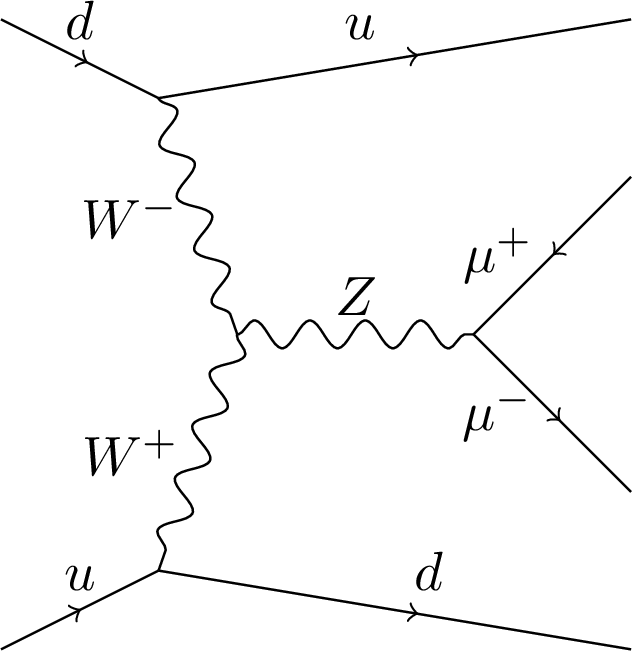
png pdf |
Figure 1-a:
Representative Feynman diagram for dilepton production in association with two jets from purely electroweak amplitudes: vector boson fusion. |

png pdf |
Figure 1-b:
Representative Feynman diagram for dilepton production in association with two jets from purely electroweak amplitudes: bremsstrahlung-like. |
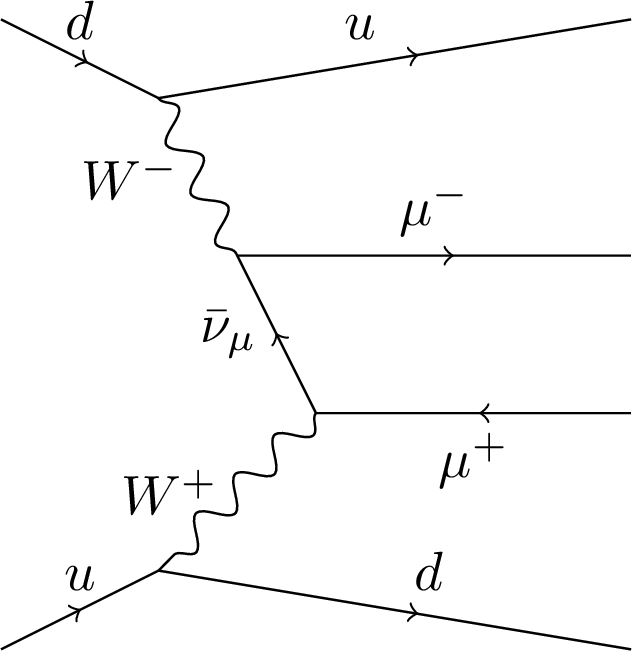
png pdf |
Figure 1-c:
Representative Feynman diagram for dilepton production in association with two jets from purely electroweak amplitudes: multiperipheral production. |
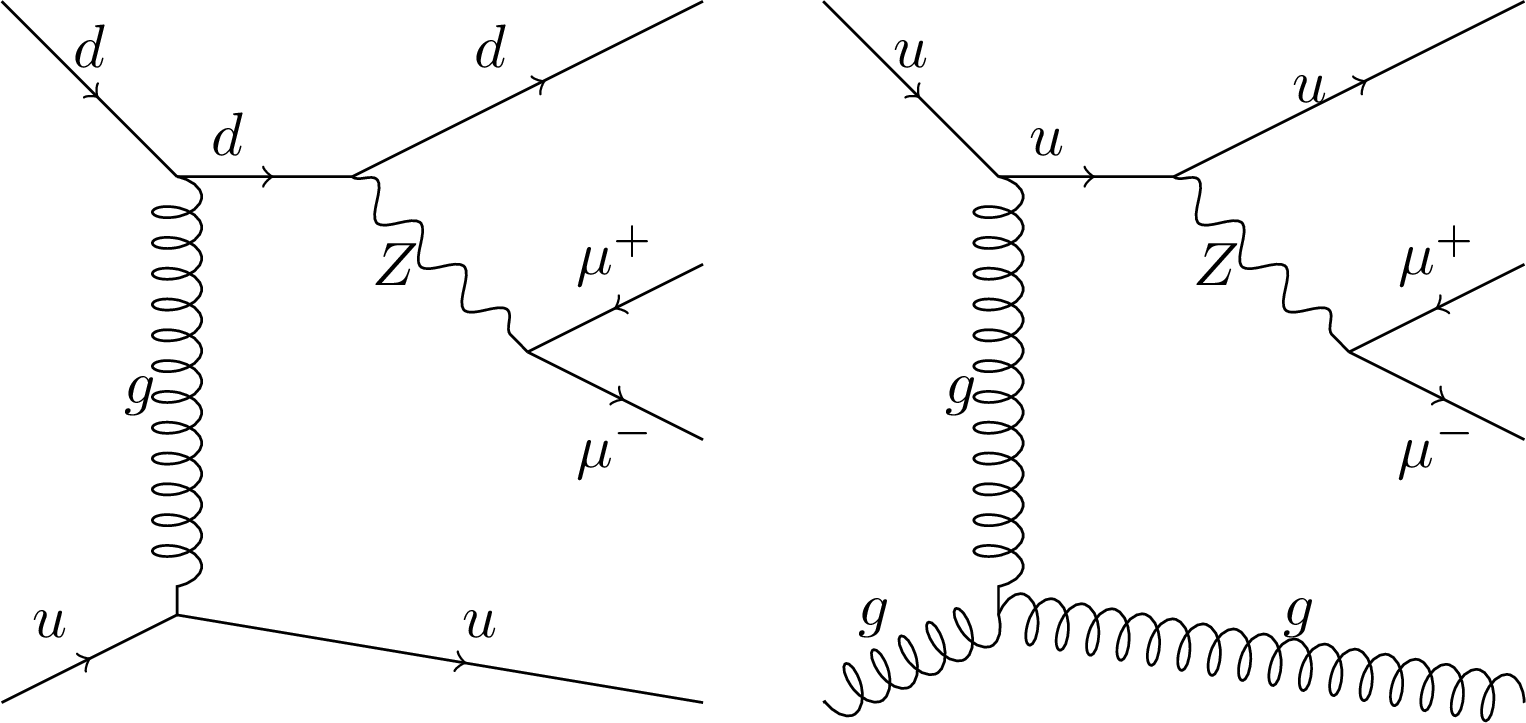
png pdf |
Figure 2:
Representative diagrams for order $\alpha _\mathrm {S}^2$ corrections to DY production that comprise the main background for the measurement. |
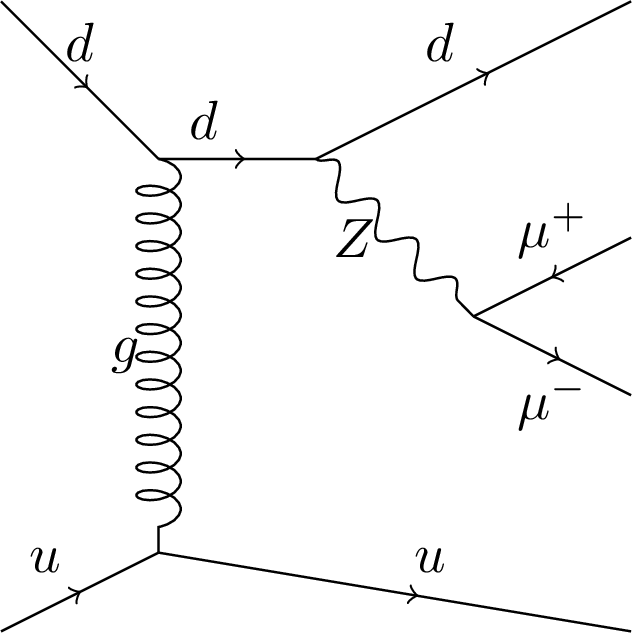
png pdf |
Figure 2-a:
Representative diagram for order $\alpha _\mathrm {S}^2$ corrections to DY production that comprise the main background for the measurement. |
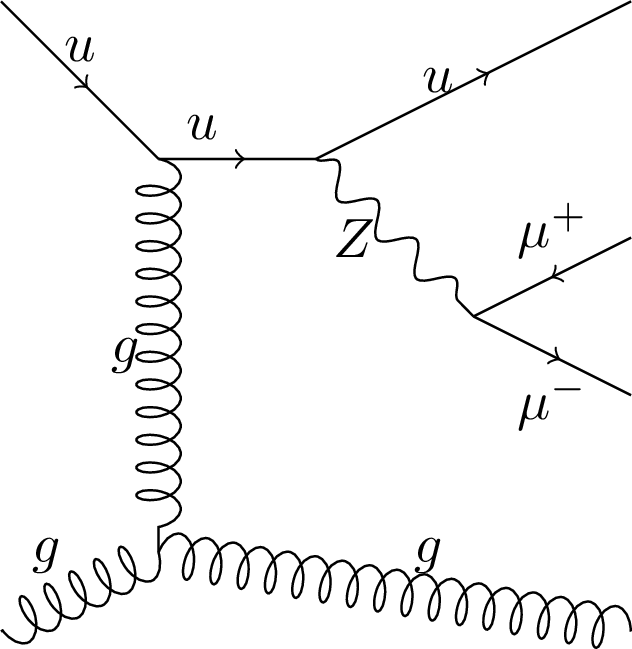
png pdf |
Figure 2-b:
Representative diagram for order $\alpha _\mathrm {S}^2$ corrections to DY production that comprise the main background for the measurement. |

png pdf |
Figure 3:
Data and simulated distributions for the dielectron event selection: invariant mass of the dijet system (top left), $R\left ( {p_{\mathrm {T}}} ^\text {hard}\right )$ (top right), and $z^*$ distribution (bottom). The contributions from the different background sources and the signal are shown stacked, with data points superimposed. The expected signal-only contribution is also shown as an unfilled histogram. The lower panels show the relative difference between the data and expectations as well as the uncertainty envelopes for JES and QCD scales uncertainties. |

png pdf |
Figure 3-a:
Data and simulated distribution for the dielectron event selection: invariant mass of the dijet system distribution. The contributions from the different background sources and the signal are shown stacked, with data points superimposed. The expected signal-only contribution is also shown as an unfilled histogram. The lower panel shows the relative difference between the data and expectations as well as the uncertainty envelopes for JES and QCD scales uncertainties. |

png pdf |
Figure 3-b:
Data and simulated distribution for the dielectron event selection: $R\left ( {p_{\mathrm {T}}} ^\text {hard}\right )$ distribution. The contributions from the different background sources and the signal are shown stacked, with data points superimposed. The expected signal-only contribution is also shown as an unfilled histogram. The lower panel shows the relative difference between the data and expectations as well as the uncertainty envelopes for JES and QCD scales uncertainties. |
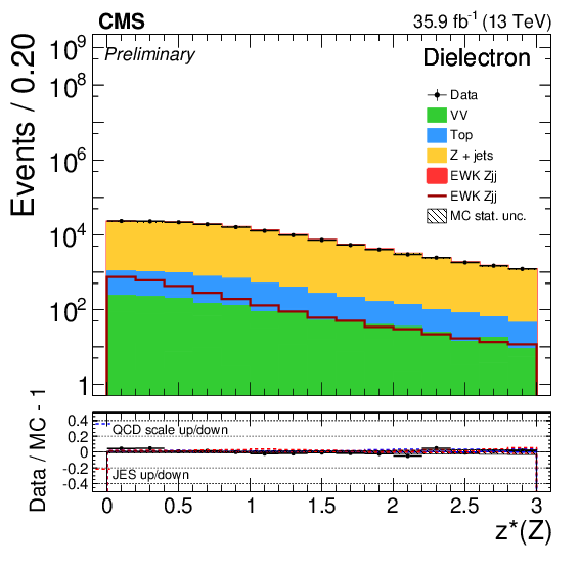
png pdf |
Figure 3-c:
Data and simulated distribution for the dielectron event selection: $z^*$ distribution. The contributions from the different background sources and the signal are shown stacked, with data points superimposed. The expected signal-only contribution is also shown as an unfilled histogram. The lower panel shows the relative difference between the data and expectations as well as the uncertainty envelopes for JES and QCD scales uncertainties. |
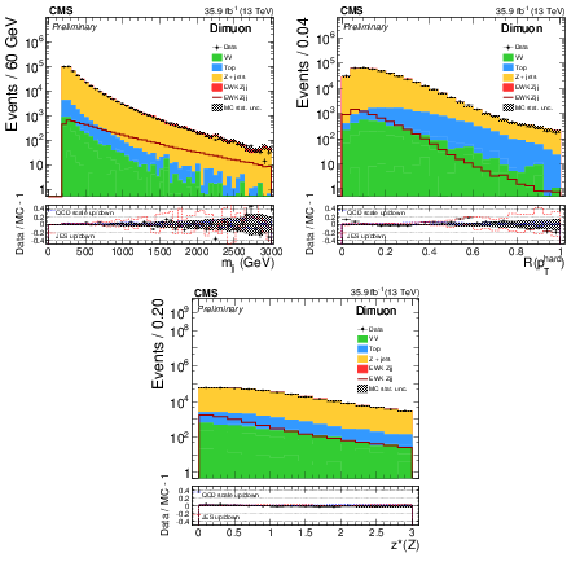
png pdf |
Figure 4:
Data and simulated distributions for the dimuon event selection: invariant mass of the dijet system (top left), $R\left ( {p_{\mathrm {T}}} ^\text {hard}\right )$ (top right), and $z^*$ distribution (bottom). The contributions from the different background sources and the signal are shown stacked, with data points superimposed. The expected signal-only contribution is also shown as an unfilled histogram. The lower panels show the relative difference between the data and expectations as well as the uncertainty envelopes for JES and QCD scales uncertainties. |

png pdf |
Figure 4-a:
Data and simulated distribution for the dimuon event selection: invariant mass of the dijet system distribution. The contributions from the different background sources and the signal are shown stacked, with data points superimposed. The expected signal-only contribution is also shown as an unfilled histogram. The lower panel shows the relative difference between the data and expectations as well as the uncertainty envelopes for JES and QCD scales uncertainties. |
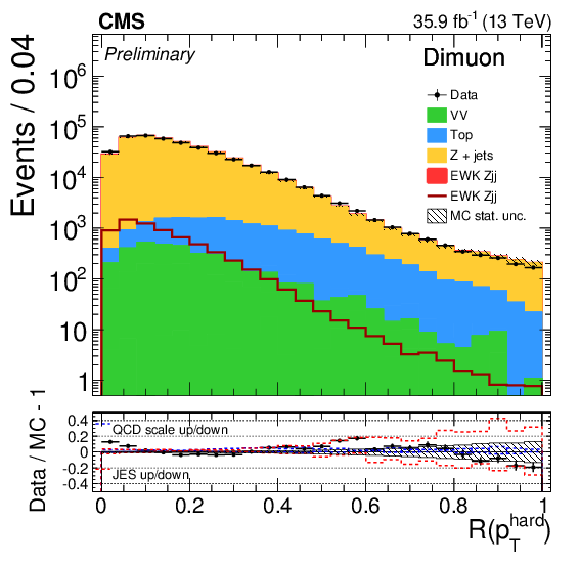
png pdf |
Figure 4-b:
Data and simulated distribution for the dimuon event selection: $R\left ( {p_{\mathrm {T}}} ^\text {hard}\right )$ distribution. The contributions from the different background sources and the signal are shown stacked, with data points superimposed. The expected signal-only contribution is also shown as an unfilled histogram. The lower panel shows the relative difference between the data and expectations as well as the uncertainty envelopes for JES and QCD scales uncertainties. |
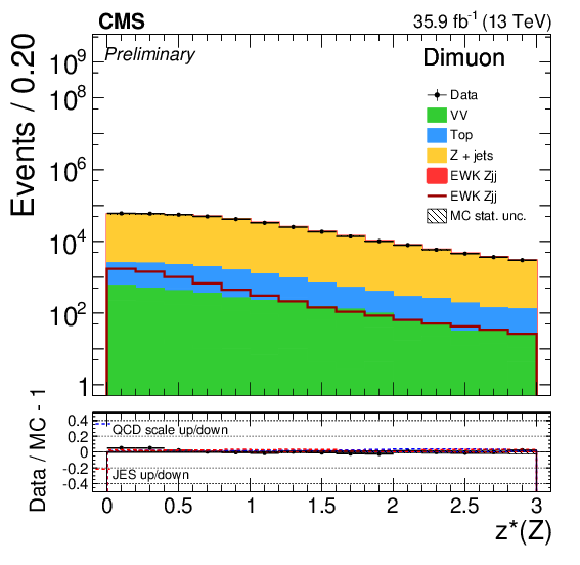
png pdf |
Figure 4-c:
Data and simulated distribution for the dimuon event selection: $z^*$ distribution. The contributions from the different background sources and the signal are shown stacked, with data points superimposed. The expected signal-only contribution is also shown as an unfilled histogram. The lower panel shows the relative difference between the data and expectations as well as the uncertainty envelopes for JES and QCD scales uncertainties. |
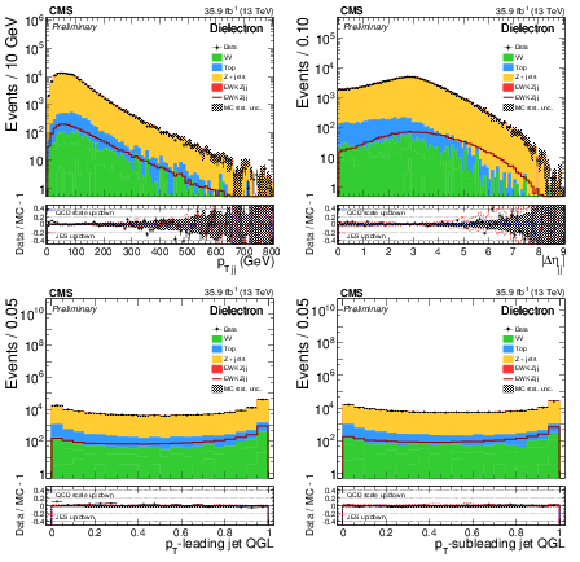
png pdf |
Figure 5:
Data and simulated distributions for the dielectron event selection: dijet system transverse momentum (top left), dijet pseudorapidity opening (top right), ${p_{\mathrm {T}}} $-leading jet QGL (bottom left) and ${p_{\mathrm {T}}} $-subleading jet QGL (bottom right). The contributions from the different background sources and the signal are shown stacked, with data points superimposed. The expected signal-only contribution is also shown as an unfilled histogram. The lower panels show the relative difference between the data and expectations as well as the uncertainty envelopes for JES and QCD scales uncertainties. |
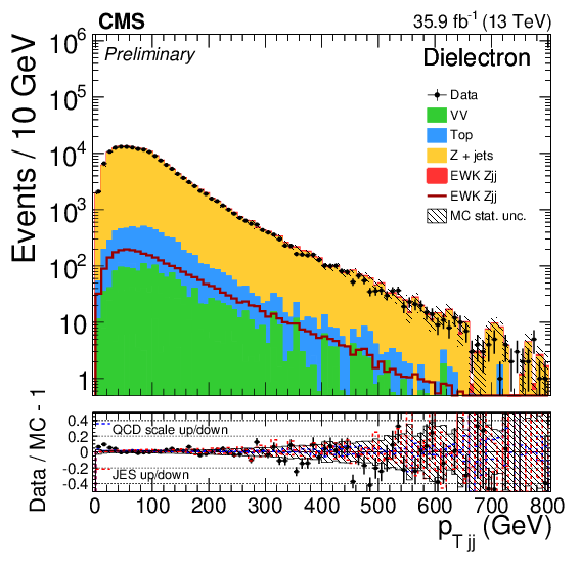
png pdf |
Figure 5-a:
Data and simulated distribution for the dielectron event selection: dijet system transverse momentum. The contributions from the different background sources and the signal are shown stacked, with data points superimposed. The expected signal-only contribution is also shown as an unfilled histogram. The lower panel shows the relative difference between the data and expectations as well as the uncertainty envelopes for JES and QCD scales uncertainties. |
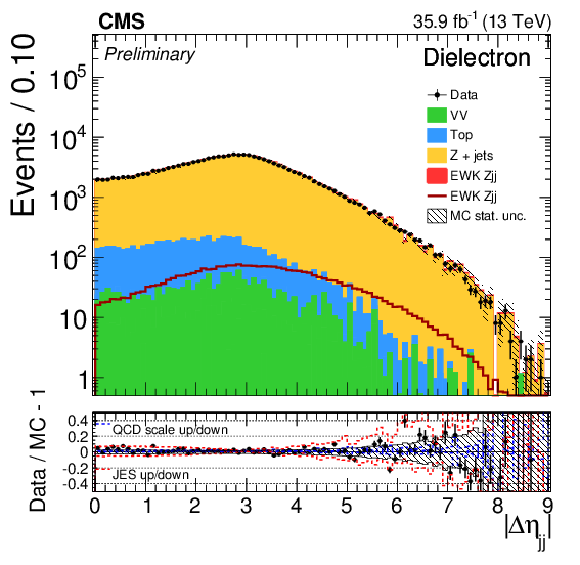
png pdf |
Figure 5-b:
Data and simulated distribution for the dielectron event selection: dijet pseudorapidity opening. The contributions from the different background sources and the signal are shown stacked, with data points superimposed. The expected signal-only contribution is also shown as an unfilled histogram. The lower panel shows the relative difference between the data and expectations as well as the uncertainty envelopes for JES and QCD scales uncertainties. |
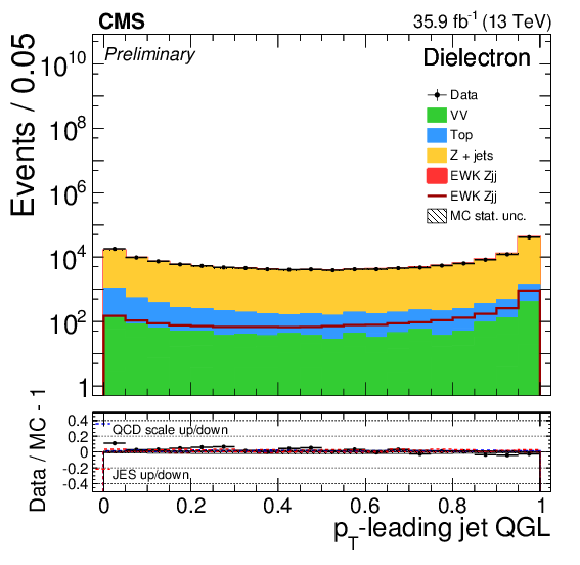
png pdf |
Figure 5-c:
Data and simulated distribution for the dielectron event selection: ${p_{\mathrm {T}}} $-leading jet QGL. The contributions from the different background sources and the signal are shown stacked, with data points superimposed. The expected signal-only contribution is also shown as an unfilled histogram. The lower panel shows the relative difference between the data and expectations as well as the uncertainty envelopes for JES and QCD scales uncertainties. |
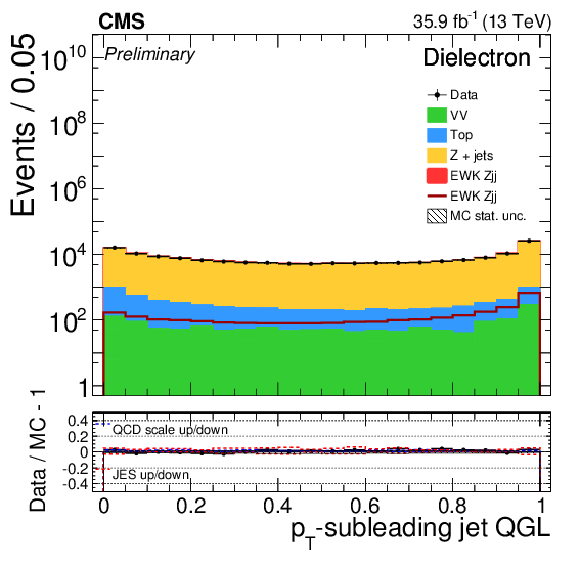
png pdf |
Figure 5-d:
Data and simulated distribution for the dielectron event selection: ${p_{\mathrm {T}}} $-subleading jet QGL. The contributions from the different background sources and the signal are shown stacked, with data points superimposed. The expected signal-only contribution is also shown as an unfilled histogram. The lower panel shows the relative difference between the data and expectations as well as the uncertainty envelopes for JES and QCD scales uncertainties. |
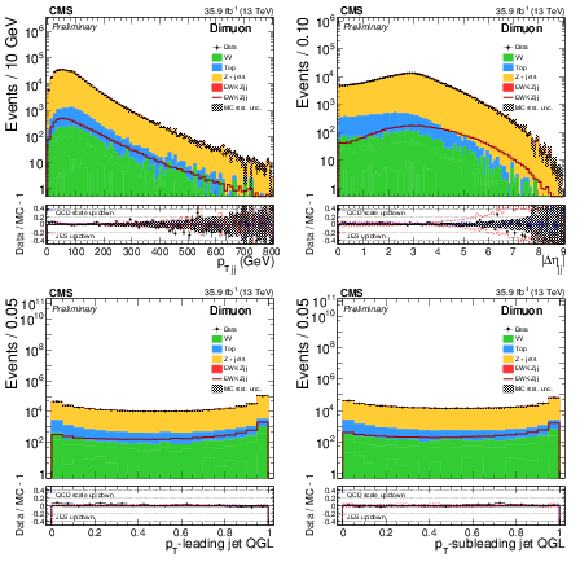
png pdf |
Figure 6:
Data and simulated distributions for the dimuon event selection: dijet system transverse momentum (top left), dijet pseudorapidity opening (top right), ${p_{\mathrm {T}}} $-leading jet QGL (bottom left) and ${p_{\mathrm {T}}} $-subleading jet QGL (bottom right). The contributions from the different background sources and the signal are shown stacked, with data points superimposed. The expected signal-only contribution is also shown as an unfilled histogram. The lower panels show the relative difference between the data and expectations as well as the uncertainty envelopes for JES and QCD scales uncertainties. |

png pdf |
Figure 6-a:
Data and simulated distribution for the dimuon event selection: dijet system transverse momentum. The contributions from the different background sources and the signal are shown stacked, with data points superimposed. The expected signal-only contribution is also shown as an unfilled histogram. The lower panel shows the relative difference between the data and expectations as well as the uncertainty envelopes for JES and QCD scales uncertainties. |
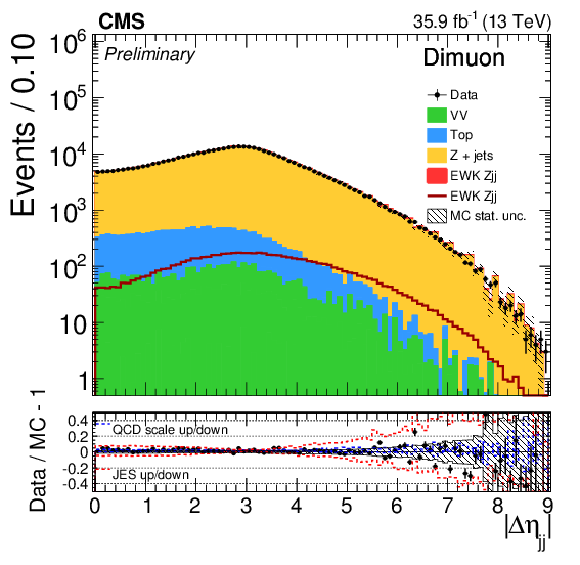
png pdf |
Figure 6-b:
Data and simulated distribution for the dimuon event selection: dijet pseudorapidity opening. The contributions from the different background sources and the signal are shown stacked, with data points superimposed. The expected signal-only contribution is also shown as an unfilled histogram. The lower panel shows the relative difference between the data and expectations as well as the uncertainty envelopes for JES and QCD scales uncertainties. |

png pdf |
Figure 6-c:
Data and simulated distribution for the dimuon event selection: ${p_{\mathrm {T}}} $-leading jet QGL. The contributions from the different background sources and the signal are shown stacked, with data points superimposed. The expected signal-only contribution is also shown as an unfilled histogram. The lower panel shows the relative difference between the data and expectations as well as the uncertainty envelopes for JES and QCD scales uncertainties. |
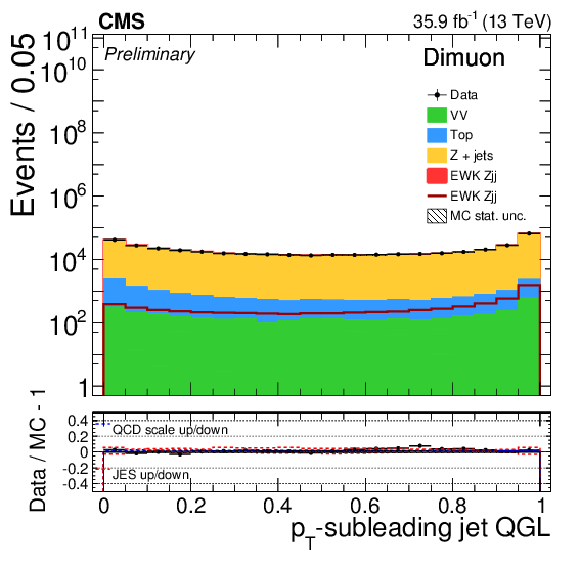
png pdf |
Figure 6-d:
Data and simulated distribution for the dimuon event selection: ${p_{\mathrm {T}}} $-subleading jet QGL. The contributions from the different background sources and the signal are shown stacked, with data points superimposed. The expected signal-only contribution is also shown as an unfilled histogram. The lower panel shows the relative difference between the data and expectations as well as the uncertainty envelopes for JES and QCD scales uncertainties. |

png pdf |
Figure 7:
Distributions for the BDT discriminants in dielectron (left) and dimuon (right) events. The contributions from the different background sources and the signal are shown stacked, with data points superimposed. The expected signal-only contribution is also shown as an unfilled histogram. The lower panels show the relative difference between the data and expectations as well as the uncertainty envelopes for JES and QCD scales uncertainties. |
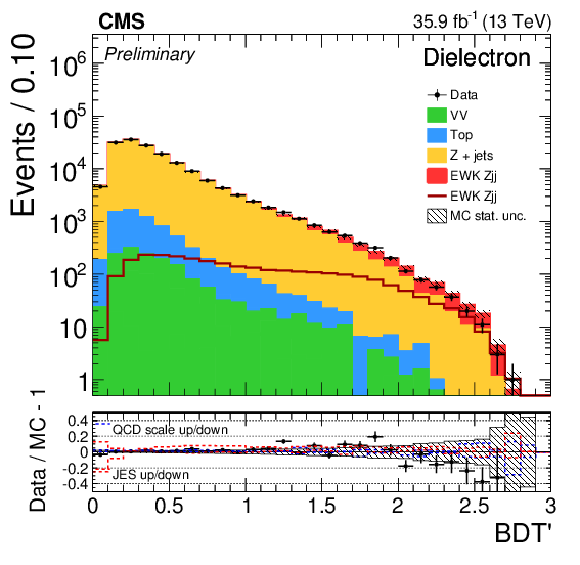
png pdf |
Figure 7-a:
Distributions for the BDT discriminants in dielectron events. The contributions from the different background sources and the signal are shown stacked, with data points superimposed. The expected signal-only contribution is also shown as an unfilled histogram. The lower panel shows the relative difference between the data and expectations as well as the uncertainty envelopes for JES and QCD scales uncertainties. |
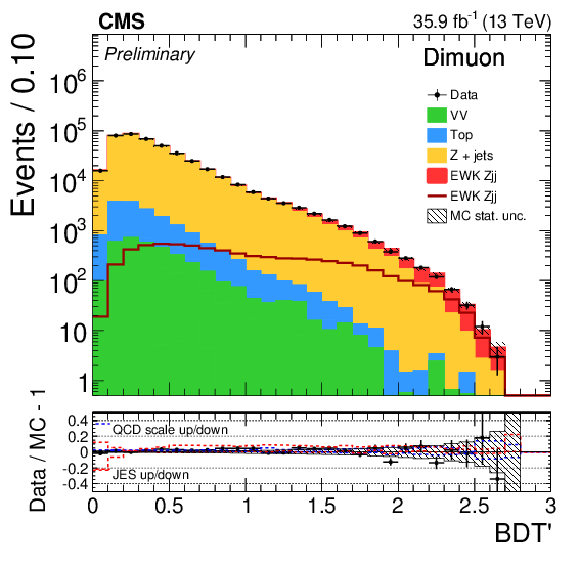
png pdf |
Figure 7-b:
Distributions for the BDT discriminants in dimuon events. The contributions from the different background sources and the signal are shown stacked, with data points superimposed. The expected signal-only contribution is also shown as an unfilled histogram. The lower panel shows the relative difference between the data and expectations as well as the uncertainty envelopes for JES and QCD scales uncertainties. |
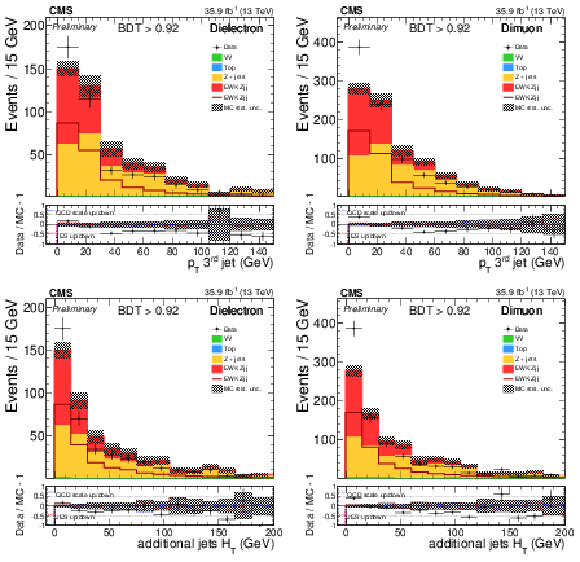
png pdf |
Figure 8:
Transverse momentum of the third ${p_{\mathrm {T}}} $-leading jet (top row), and $ {H_{\mathrm {T}}} $ of all additional jets (bottom row) within the pseudorapidity interval of the two tagging jets in dielectron (left) and dimuon (right) events with BDT $>$ 0.92. The contributions from the different background sources and the signal are shown stacked, with data points superimposed. The expected signal-only contribution is also shown as an unfilled histogram. The lower panels show the relative difference between the data and expectations as well as the uncertainty envelopes for JES and QCD scales uncertainties. In all plots the first bin contains events where no additional jet with ${p_{\mathrm {T}}} > $ 15 GeV is present. |

png pdf |
Figure 8-a:
Transverse momentum of the third ${p_{\mathrm {T}}} $-leading jet within the pseudorapidity interval of the two tagging jets in dielectron events with BDT $>$ 0.92. The contributions from the different background sources and the signal are shown stacked, with data points superimposed. The expected signal-only contribution is also shown as an unfilled histogram. The lower panel shows the relative difference between the data and expectations as well as the uncertainty envelopes for JES and QCD scales uncertainties. In all plots the first bin contains events where no additional jet with ${p_{\mathrm {T}}} > $ 15 GeV is present. |
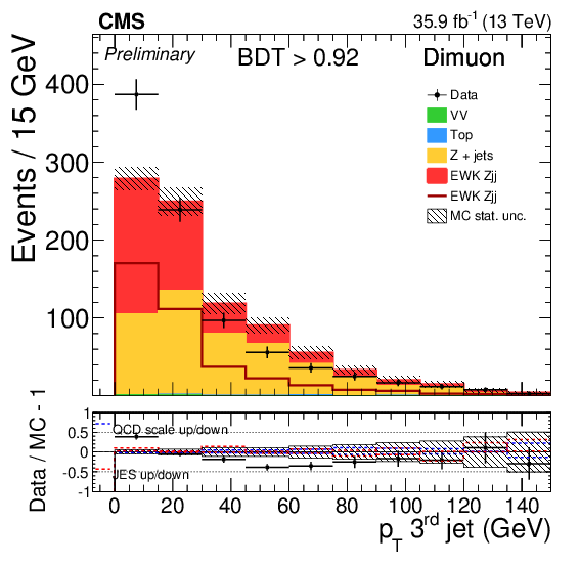
png pdf |
Figure 8-b:
Transverse momentum of the third ${p_{\mathrm {T}}} $-leading jet within the pseudorapidity interval of the two tagging jets in dimuon events with BDT $>$ 0.92. The contributions from the different background sources and the signal are shown stacked, with data points superimposed. The expected signal-only contribution is also shown as an unfilled histogram. The lower panel shows the relative difference between the data and expectations as well as the uncertainty envelopes for JES and QCD scales uncertainties. In all plots the first bin contains events where no additional jet with ${p_{\mathrm {T}}} > $ 15 GeV is present. |

png pdf |
Figure 8-c:
$ {H_{\mathrm {T}}} $ of all additional jets within the pseudorapidity interval of the two tagging jets in dielectron events with BDT $>$ 0.92. The contributions from the different background sources and the signal are shown stacked, with data points superimposed. The expected signal-only contribution is also shown as an unfilled histogram. The lower panel shows the relative difference between the data and expectations as well as the uncertainty envelopes for JES and QCD scales uncertainties. In all plots the first bin contains events where no additional jet with ${p_{\mathrm {T}}} > $ 15 GeV is present. |

png pdf |
Figure 8-d:
$ {H_{\mathrm {T}}} $ of all additional jets within the pseudorapidity interval of the two tagging jets in dimuon events with BDT $>$ 0.92. The contributions from the different background sources and the signal are shown stacked, with data points superimposed. The expected signal-only contribution is also shown as an unfilled histogram. The lower panel shows the relative difference between the data and expectations as well as the uncertainty envelopes for JES and QCD scales uncertainties. In all plots the first bin contains events where no additional jet with ${p_{\mathrm {T}}} > $ 15 GeV is present. |

png pdf |
Figure 9:
$ {H_{\mathrm {T}}} $ of additional soft track jets with $ {p_{\mathrm {T}}} > $ 1 GeV in dielectron (left) and dimuon (right) events with BDT $>$ 0.92. Data is compared to MC expectations with the PYTHIA PS model (top row) or the HERWIG++ PS model (bottom row). The contributions from the different background sources and the signal are shown stacked, with data points superimposed. The expected signal-only contribution is also shown as an unfilled histogram. The lower panels show the relative difference between the data and expectations as well as the uncertainty envelopes for JES and QCD scales uncertainties. |
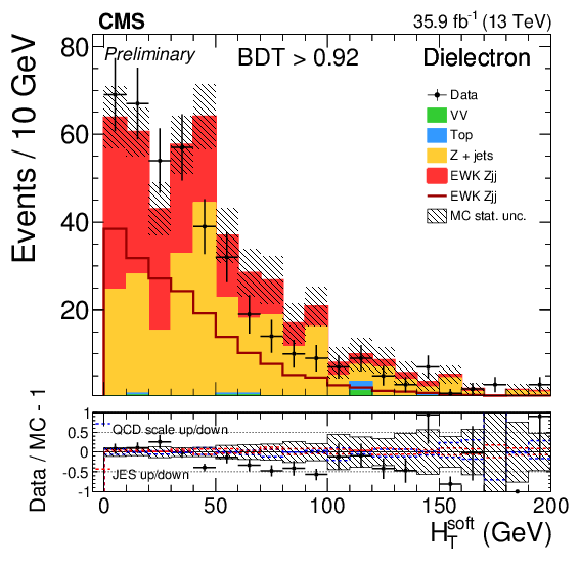
png pdf |
Figure 9-a:
$ {H_{\mathrm {T}}} $ of additional soft track jets with $ {p_{\mathrm {T}}} > $ 1 GeV in dielectron events with BDT $>$ 0.92. Data is compared to MC expectations with the PYTHIA PS model. The contributions from the different background sources and the signal are shown stacked, with data points superimposed. The expected signal-only contribution is also shown as an unfilled histogram. The lower panel shows the relative difference between the data and expectations as well as the uncertainty envelopes for JES and QCD scales uncertainties. |

png pdf |
Figure 9-b:
$ {H_{\mathrm {T}}} $ of additional soft track jets with $ {p_{\mathrm {T}}} > $ 1 GeV in dimuon events with BDT $>$ 0.92. Data is compared to MC expectations with the PYTHIA PS model. The contributions from the different background sources and the signal are shown stacked, with data points superimposed. The expected signal-only contribution is also shown as an unfilled histogram. The lower panel shows the relative difference between the data and expectations as well as the uncertainty envelopes for JES and QCD scales uncertainties. |
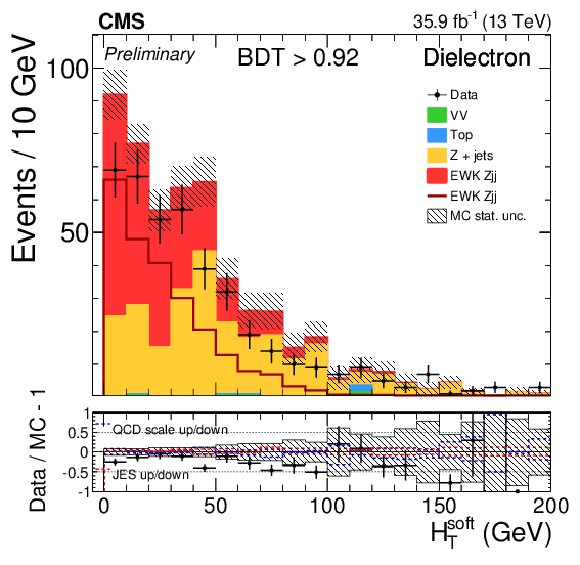
png pdf |
Figure 9-c:
$ {H_{\mathrm {T}}} $ of additional soft track jets with $ {p_{\mathrm {T}}} > $ 1 GeV in dielectron events with BDT $>$ 0.92. Data is compared to MC expectations with the HERWIG++ PS model. The contributions from the different background sources and the signal are shown stacked, with data points superimposed. The expected signal-only contribution is also shown as an unfilled histogram. The lower panel shows the relative difference between the data and expectations as well as the uncertainty envelopes for JES and QCD scales uncertainties. |
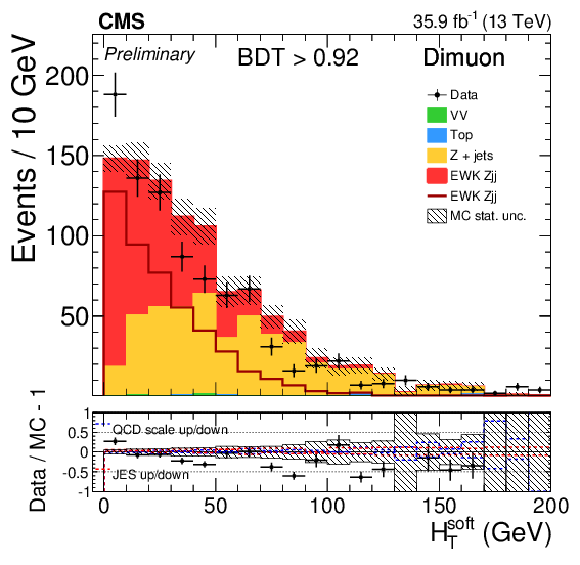
png pdf |
Figure 9-d:
$ {H_{\mathrm {T}}} $ of additional soft track jets with $ {p_{\mathrm {T}}} > $ 1 GeV in dimuon events with BDT $>$ 0.92. Data is compared to MC expectations with the HERWIG++ PS model. The contributions from the different background sources and the signal are shown stacked, with data points superimposed. The expected signal-only contribution is also shown as an unfilled histogram. The lower panel shows the relative difference between the data and expectations as well as the uncertainty envelopes for JES and QCD scales uncertainties. |

png pdf |
Figure 10:
Efficiency of a gap activity veto in dielectron and dimuon events with BDT $>$ 0.92, as a function of the additional jet ${p_{\mathrm {T}}}$ (left), and of the total ${H_{\mathrm {T}}}$ of additional jets (right). Data points are compared to MC expectations with only DY events, including signal the PYTHIA PS model, or the HERWIG++ PS model. The bands represent the MC statistical uncertainty. |
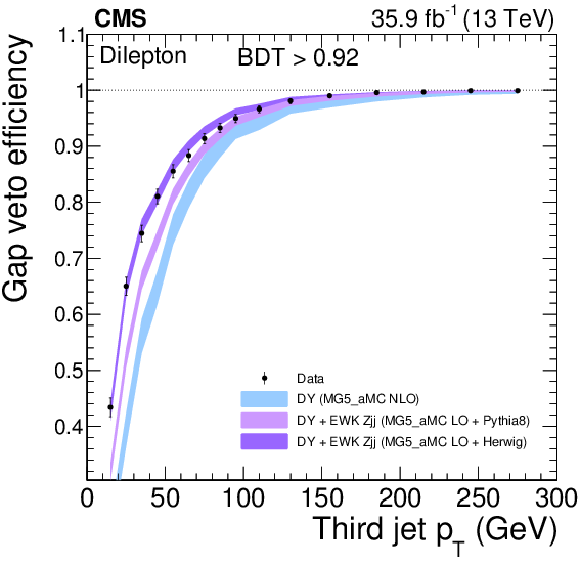
png pdf |
Figure 10-a:
Efficiency of a gap activity veto in dielectron and dimuon events with BDT $>$ 0.92, as a function of the additional jet ${p_{\mathrm {T}}}$. Data points are compared to MC expectations with only DY events, including signal the PYTHIA PS model, or the HERWIG++ PS model. The bands represent the MC statistical uncertainty. |
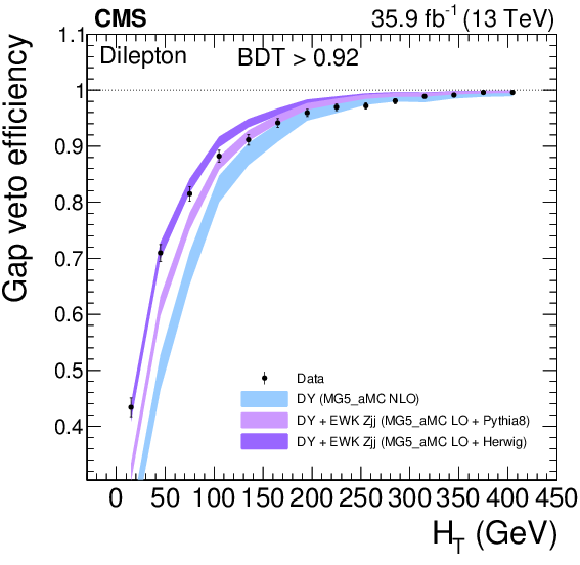
png pdf |
Figure 10-b:
Efficiency of a gap activity veto in dielectron and dimuon events with BDT $>$ 0.92, as a function of the total ${H_{\mathrm {T}}}$ of additional jets. Data points are compared to MC expectations with only DY events, including signal the PYTHIA PS model, or the HERWIG++ PS model. The bands represent the MC statistical uncertainty. |
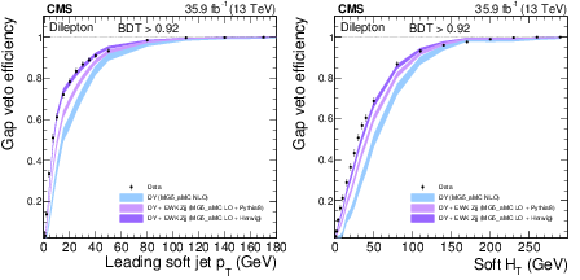
png pdf |
Figure 11:
Efficiency of a gap activity veto in dielectron and dimuon events with BDT $>$ 0.92, as a function of the leading soft jet ${p_{\mathrm {T}}}$ (left), and of the total soft ${H_{\mathrm {T}}}$ (right). Data points are compared to MC expectations with only DY events, including signal the PYTHIA PS model, or the HERWIG++ PS model. The bands represent the MC statistical uncertainty. |
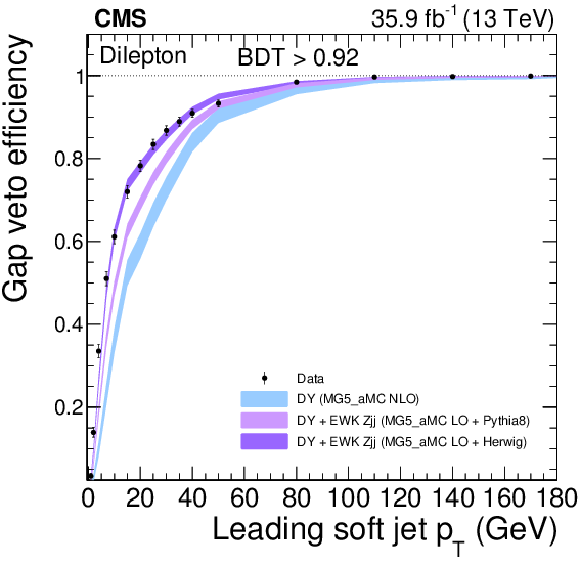
png pdf |
Figure 11-a:
Efficiency of a gap activity veto in dielectron and dimuon events with BDT $>$ 0.92, as a function of the leading soft jet ${p_{\mathrm {T}}}$. Data points are compared to MC expectations with only DY events, including signal the PYTHIA PS model, or the HERWIG++ PS model. The bands represent the MC statistical uncertainty. |
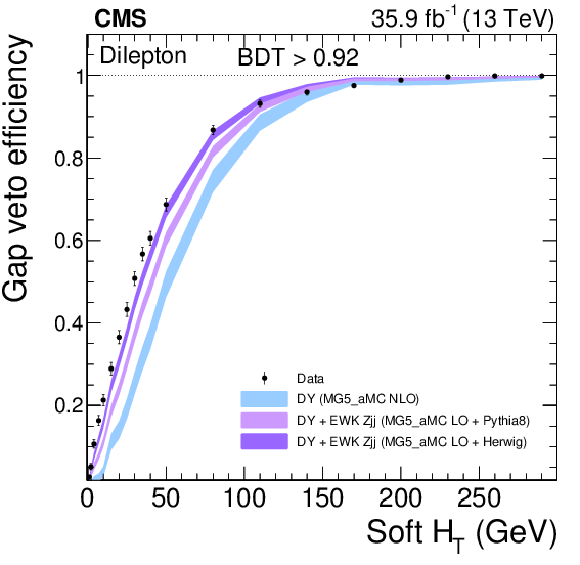
png pdf |
Figure 11-b:
Efficiency of a gap activity veto in dielectron and dimuon events with BDT $>$ 0.92, as a function of the total soft ${H_{\mathrm {T}}}$. Data points are compared to MC expectations with only DY events, including signal the PYTHIA PS model, or the HERWIG++ PS model. The bands represent the MC statistical uncertainty. |
| Summary |
|
The cross section for the electroweak production of a Z boson in association with two jets in the $\ell\ell \mathrm{jj} $ final state, in proton-proton collisions at $ \sqrt{s} = $ 13 TeV has been measured to be |
| References | ||||
| 1 | C. Oleari and D. Zeppenfeld | QCD corrections to electroweak $ \ell\nu_\ell $jj and $ \ell^+\ell^- $jj production | PRD 69 (2004) 093004 | hep-ph/0310156 |
| 2 | ATLAS Collaboration | Observation of a new particle in the search for the Standard Model Higgs boson with the ATLAS detector at the LHC | PLB 716 (2012) 1 | 1207.7214 |
| 3 | CMS Collaboration | Observation of a new boson at a mass of 125 GeV with the CMS experiment at the LHC | PLB 716 (2012) 30 | CMS-HIG-12-028 1207.7235 |
| 4 | CMS Collaboration | Observation of a new boson with mass near 125 GeV in pp collisions at $ \sqrt{s} = $ 7 and 8 TeV | JHEP 06 (2013) 081 | CMS-HIG-12-036 1303.4571 |
| 5 | G.-C. Cho et al. | Weak boson fusion production of supersymmetric particles at the CERN LHC | PRD 73 (2006) 054002 | hep-ph/0601063 |
| 6 | J. D. Bjorken | Rapidity gaps and jets as a new physics signature in very high-energy hadron hadron collisions | PRD 47 (1993) 101 | |
| 7 | F. Schissler and D. Zeppenfeld | Parton shower effects on W and Z production via vector boson fusion at NLO QCD | JHEP 04 (2013) 057 | 1302.2884 |
| 8 | CMS Collaboration | Measurement of the hadronic activity in events with a Z and two jets and extraction of the cross section for the electroweak production of a Z with two jets in pp collisions at $ \sqrt{s} = $ 7 TeV | JHEP 10 (2013) 062 | CMS-FSQ-12-019 1305.7389 |
| 9 | ATLAS Collaboration | Measurement of the electroweak production of dijets in association with a Z-boson and distributions sensitive to vector boson fusion in proton-proton collisions at $ \sqrt{s} = $ 8 TeV using the ATLAS detector | JHEP 04 (2014) 031 | 1401.7610 |
| 10 | CMS Collaboration | Measurement of electroweak production of two jets in association with a Z boson in proton-proton collisions at $ \sqrt{s}= $ 8 TeV | EPJC75 (2015), no. 2, 66 | CMS-FSQ-12-035 1410.3153 |
| 11 | CMS Collaboration | Description and performance of track and primary-vertex reconstruction with the CMS tracker | JINST 9 (2014) P10009 | CMS-TRK-11-001 1405.6569 |
| 12 | CMS Collaboration | Performance of electron reconstruction and selection with the CMS detector in proton-proton collisions at $ \sqrt{s}= $ 8 TeV | JINST 10 (2015) P06005 | CMS-EGM-13-001 1502.02701 |
| 13 | CMS Collaboration Collaboration | Performance of CMS muon reconstruction in $ pp $ collision events at $ \sqrt{s}= $ 7 TeV | JINST 7 (2012) P10002 | 1206.4071 |
| 14 | CMS Collaboration | Determination of jet energy calibration and transverse momentum resolution in CMS | JINST 6 (2011) P11002 | CMS-JME-10-011 1107.4277 |
| 15 | CMS Collaboration | The CMS experiment at the CERN LHC | JINST 3 (2008) S08004 | CMS-00-001 |
| 16 | J. Alwall et al. | MadGraph 5: going beyond | JHEP 06 (2011) 128 | 1106.0522 |
| 17 | J. Alwall et al. | The automated computation of tree-level and next-to-leading order differential cross sections, and their matching to parton shower simulations | JHEP 07 (2014) 079 | 1405.0301 |
| 18 | T. Sjostrand, S. Mrenna, and P. Skands | A brief introduction to PYTHIA 8.1 | CPC 178 (2008) 852 | 0710.3820 |
| 19 | T. Sjostrand et al. | An Introduction to PYTHIA 8.2 | CPC 191 (2015) 159--177 | 1410.3012 |
| 20 | NNPDF Collaboration | Unbiased global determination of parton distributions and their uncertainties at NNLO and at LO | NP B855 (2012) 153--221 | 1107.2652 |
| 21 | CMS Collaboration | Event generator tunes obtained from underlying event and multiparton scattering measurements | CMS-GEN-14-001 1512.00815 |
|
| 22 | K. Arnold et al. | VBFNLO: A parton level Monte Carlo for processes with electroweak bosons | CPC 180 (2009) 1661 | 0811.4559 |
| 23 | J. Baglio et al. | VBFNLO: a parton level Monte Carlo for processes with electroweak bosons --- manual for version 2.7.0 | 1107.4038 | |
| 24 | K. Arnold et al. | Release Note -- VBFNLO-2.6.0 | 1207.4975 | |
| 25 | R. Frederix and S. Frixione | Merging meets matching in MC@NLO | JHEP 12 (2012) 061 | 1209.6215 |
| 26 | M. L. Mangano, M. Moretti, F. Piccinini, and M. Treccani | Matching matrix elements and shower evolution for top-quark production in hadronic collisions | JHEP 01 (2007) 013 | hep-ph/0611129 |
| 27 | J. Alwall et al. | Comparative study of various algorithms for the merging of parton showers and matrix elements in hadronic collisions | EPJC 53 (2008) 473 | 0706.2569 |
| 28 | K. Melnikov and F. Petriello | Electroweak gauge boson production at hadron colliders through $ O(\alpha_S^2) $ | PRD 74 (2006) 114017 | hep-ph/0609070 |
| 29 | P. Nason | A new method for combining NLO QCD with shower Monte Carlo algorithms | JHEP 11 (2004) 040 | hep-ph/0409146 |
| 30 | S. Frixione, P. Nason, and C. Oleari | Matching NLO QCD computations with parton shower simulations: the POWHEG method | JHEP 11 (2007) 070 | 0709.2092 |
| 31 | S. Alioli, P. Nason, C. Oleari, and E. Re | A general framework for implementing NLO calculations in shower Monte Carlo programs: the POWHEG BOX | JHEP 06 (2010) 043 | 1002.2581 |
| 32 | N. Kidonakis | Differential and total cross sections for top pair and single top production | in Proceedings of the XX International Workshop on Deep-Inelastic Scattering and Related Subjects Bonn, Germany | 1205.3453 |
| 33 | M. Czakon, P. Fiedler, and A. Mitov | Total Top-Quark Pair-Production Cross Section at Hadron Colliders Through O($ \alpha_S^4 $) | PRL 110 (2013) 252004 | 1303.6254 |
| 34 | S. Alioli, P. Nason, C. Oleari, and E. Re | NLO single-top production matched with shower in POWHEG: $ \it $ s- and $ \it $ t-channel contributions | JHEP 09 (2009) 111 | 0907.4076 |
| 35 | E. Re | Single-top $ \it $ Wt-channel production matched with parton showers using the POWHEG method | EPJC 71 (2011) 1547 | 1009.2450 |
| 36 | N. Kidonakis | Top Quark Production | 1311.0283 | |
| 37 | J. M. Campbell and R. K. Ellis | MCFM for the Tevatron and the LHC | Nucl. Phys. B Proc. Suppl. 205-206 (2010) 10 | 1007.3492 |
| 38 | J. Allison et al. | Geant4 developments and applications | IEEE Trans. Nucl. Sci. 53 (2006) 270 | |
| 39 | GEANT4 Collaboration | GEANT4---a simulation toolkit | NIMA 506 (2003) 250 | |
| 40 | CMS Collaboration | Performance of CMS muon reconstruction in pp collision events at $ \sqrt{s} = $ 7 TeV | JINST 7 (2012) P10002 | CMS-MUO-10-004 1206.4071 |
| 41 | Particle Data Group Collaboration | Review of Particle Physics | CPC40 (2016), no. 10, 100001 | |
| 42 | CMS Collaboration | Particle--flow event reconstruction in CMS and performance for jets, taus, and $ E_{\mathrm{T}}^{\text{miss}} $ | CDS | |
| 43 | CMS Collaboration | Commissioning of the Particle-flow Event Reconstruction with the first LHC collisions recorded in the CMS detector | CDS | |
| 44 | CMS Collaboration | Commissioning of the particle-flow reconstruction in minimum-bias and jet events from $ \mathrm{ p }\mathrm{ p } $ collisions at 7 TeV | CDS | |
| 45 | M. Cacciari and G. P. Salam | Dispelling the $ N^{3} $ myth for the $ k_{t} $ jet-finder | PLB 641 (2006) 57 | hep-ph/0512210 |
| 46 | M. Cacciari, G. P. Salam, and G. Soyez | The anti-$ k_t $ jet clustering algorithm | JHEP 04 (2008) 063 | 0802.1189 |
| 47 | CMS Collaboration | Jet algorithms performance in 13 TeV data | CMS-PAS-JME-16-003 | CMS-PAS-JME-16-003 |
| 48 | CMS Collaboration | Pileup Jet Identification | CDS | |
| 49 | CMS Collaboration | Performance of quark/gluon discrimination using pp collision data at $ \sqrt{s} = $ 8 TeV | CMS-PAS-JME-13-002 | CMS-PAS-JME-13-002 |
| 50 | H. Voss, A. Hocker, J. Stelzer, and F. Tegenfeldt | TMVA, the Toolkit for Multivariate Data Analysis with ROOT | in XIth International Workshop on Advanced Computing and Analysis Techniques in Physics Research (ACAT) | physics/0703039 |
| 51 | G. Cowan, K. Cranmer, E. Gross, and O. Vitells | Asymptotic formulae for likelihood-based tests of new physics | EPJC 71 (2011) 1554 | 1007.1727 |
| 52 | CMS Collaboration | Tracking and Primary Vertex Results in First 7 TeV Collisions | CDS | |
| 53 | CMS Collaboration | Commissioning of TrackJets in pp Collisions at $ \sqrt{s} = $ 7 TeV | CDS | |
| 54 | CMS Collaboration | Performance of jet reconstruction with charged tracks only | CDS | |

|
Compact Muon Solenoid LHC, CERN |

|

|

|

|

|

|